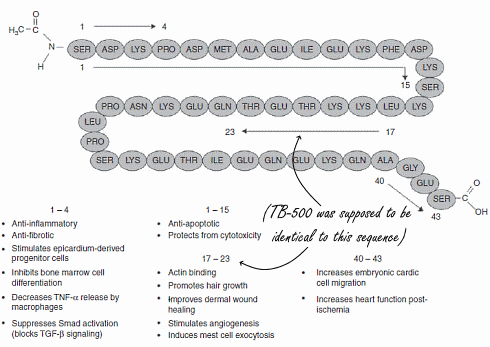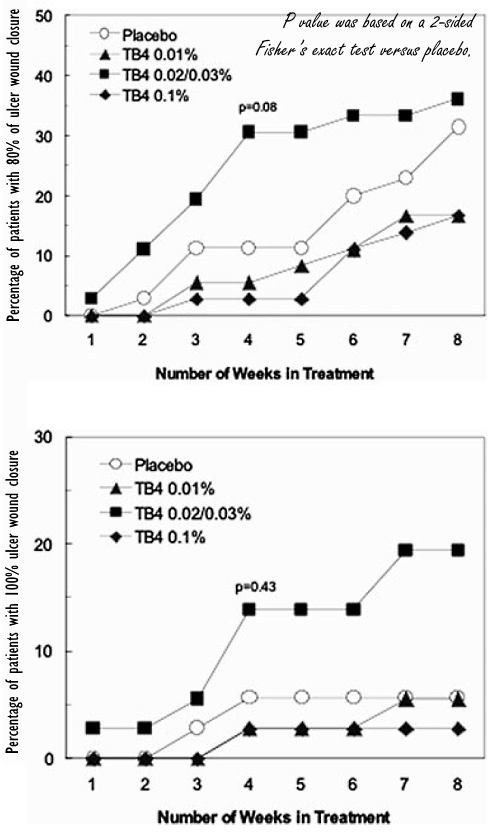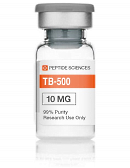Too little TB-500 does not work, neither does too much
Pharmacological athletes struggling with an injury sometimes use TB-500, an injectable research chemical, to accelerate healing. Whether TB-500 has the desired effect may well depend on the dosage, according to research from 2012. If the dose is too low and too high, TB-500 does nothing at all.TB-500
For years, sellers have said that TB-500 was a single amino acid peptide found in the body's own hormone, thymosin-beta-4. However, when German doping hunters analyzed vials of TB-500, it was found to contain the complete thymosin beta-4. Despite this, sellers of research chemicals still use the name TB-500.
Thymosin beta-4
Thymosin beta-4 is a hormone released when tissues are damaged. It stimulates recovery because it makes healthy cells more vital, the construction of small blood vessels and the cell division is increased and activates stem cells to take the place of damaged cells.

Thymosin beta-4 was discovered in the early 1980s by the lab of the American scientist Allan Goldstein. [Proc Natl Acad Sci USA. 1981 Feb;78(2):1162-6.] Goldstein and his colleagues founded the pharmaceutical company RegeneRx Biopharmaceuticals, [regenerx.com] which develops thymosin beta 4-based drugs.
That process is progressing, the figure below shows. It will not be long before thymosin beta-4 will be registered as a medicine. Click on the figure for a larger version.

In 2012, researchers from George Washington University and RegeneRx published a study summarizing the results of two trials. In total, the researchers had access to data from 143 patients with pressure ulcer wounds and stasis ulcer wounds.The researchers divided their test subjects into 4 groups. They treated the patients' wounds in the 4 groups with a gel without active ingredients [Placebo] or a gel consisting of 0.01, 0.03 or 0.1 percent thymosin beta-4, respectively. The researchers applied the gel weekly. [Ann N Y Acad Sci. 2010 Apr;1194:207-12.]
Results
The figure below shows that the gels with the lowest and highest concentration worked as well as a placebo, but the gel with 0.03 percent thymosin beta-4 accelerated recovery.

Conclusion
"It is not clear why the lower and higher doses were ineffective but thymosine-bèta-4 is a biologically active protein with a defined receptor", write the researchers. "Such bioactive molecules can have a narrow effective dose range and differing responses seen at different concentration are common to many signaling molecules."
Source:
Ann N Y Acad Sci. 2012 Oct;1270:37-44.

|
For years, sellers have said that TB-500 was a single amino acid peptide found in the body's own hormone, thymosin-beta-4. However, when German doping hunters analyzed vials of TB-500, it was found to contain the complete thymosin beta-4. Despite this, sellers of research chemicals still use the name TB-500.
Thymosin beta-4
Thymosin beta-4 is a hormone released when tissues are damaged. It stimulates recovery because it makes healthy cells more vital, the construction of small blood vessels and the cell division is increased and activates stem cells to take the place of damaged cells.

Thymosin beta-4 was discovered in the early 1980s by the lab of the American scientist Allan Goldstein. [Proc Natl Acad Sci USA. 1981 Feb;78(2):1162-6.] Goldstein and his colleagues founded the pharmaceutical company RegeneRx Biopharmaceuticals, [regenerx.com] which develops thymosin beta 4-based drugs.
That process is progressing, the figure below shows. It will not be long before thymosin beta-4 will be registered as a medicine. Click on the figure for a larger version.

Results
The figure below shows that the gels with the lowest and highest concentration worked as well as a placebo, but the gel with 0.03 percent thymosin beta-4 accelerated recovery.

Conclusion
"It is not clear why the lower and higher doses were ineffective but thymosine-bèta-4 is a biologically active protein with a defined receptor", write the researchers. "Such bioactive molecules can have a narrow effective dose range and differing responses seen at different concentration are common to many signaling molecules."
Source:
Ann N Y Acad Sci. 2012 Oct;1270:37-44.


